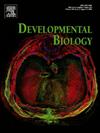A critical genetic interaction between Gemin3/Ddx20 and translation initiation factor NAT1/eIF4G2 drives development
IF 2.5
3区 生物学
Q2 DEVELOPMENTAL BIOLOGY
引用次数: 0
Abstract
Gemin3 (Gem3) or DEAD-box RNA helicase 20 (Ddx20) has been mostly implicated in the assembly of spliceosomal small nuclear ribonucleoproteins (snRNPs) as part of the SMN-Gemins complex. Nonetheless, several studies have hinted at its participation in diverse snRNP-independent activities. Here, we utilised a narrow unbiased genetic screen to discover novel Gem3 interactors in Drosophila with the aim of gaining better insights on its function in vivo. Through this approach, we identified a novel genetic interaction between Gem3 and NAT1, which encodes the Drosophila orthologue of translational regulator eIF4G2. Despite lack of a physical association, loss of NAT1 function was found to downregulate Gem3 mRNA levels. Extensive convergence in transcriptome alterations downstream of Gem3 and NAT1 silencing further supports a functional relationship between these factors in addition to showing a requirement for both in actin cytoskeleton organisation and organism development, particularly neurodevelopment. In confirmation, flies with either Gem3 or NAT1 depletion exhibited brain growth defects and reduced muscle contraction. Severe delays in developmental progression were also observed in a newly generated Gem3 hypomorphic mutant. Our data linking Gemin3 to a key component of the translational machinery support an emerging role for Gemin3 in translation that is also critical during organism development.

Gemin3/Ddx20和翻译起始因子NAT1/eIF4G2之间的关键遗传相互作用驱动了发育。
Gemin3 (Gem3)或DEAD-box RNA解旋酶20 (Ddx20)主要参与剪接体小核核糖核蛋白(snRNPs)的组装,作为SMN-Gemins复合体的一部分。尽管如此,一些研究已经暗示其参与多种snrnp独立活动。在这里,我们利用一个狭窄的无偏遗传筛选来发现果蝇中新的Gem3相互作用物,目的是更好地了解其在体内的功能。通过这种方法,我们发现了Gem3和NAT1之间的一种新的遗传相互作用,NAT1编码果蝇翻译调节因子eIF4G2的同源物。尽管缺乏物理关联,但发现NAT1功能的丧失可下调Gem3 mRNA水平。Gem3和NAT1沉默下游转录组改变的广泛趋同进一步支持了这些因子之间的功能关系,此外还显示了肌动蛋白细胞骨架组织和生物体发育,特别是神经发育的需要。证实,Gem3或NAT1缺失的果蝇表现出大脑生长缺陷和肌肉收缩减少。在新产生的Gem3半胚突变体中也观察到严重的发育进展延迟。我们的数据将Gemin3与翻译机制的一个关键组成部分联系起来,支持了Gemin3在翻译中的新兴作用,这在生物体发育过程中也至关重要。
本文章由计算机程序翻译,如有差异,请以英文原文为准。
求助全文
约1分钟内获得全文
求助全文
来源期刊

Developmental biology
生物-发育生物学
CiteScore
5.30
自引率
3.70%
发文量
182
审稿时长
1.5 months
期刊介绍:
Developmental Biology (DB) publishes original research on mechanisms of development, differentiation, and growth in animals and plants at the molecular, cellular, genetic and evolutionary levels. Areas of particular emphasis include transcriptional control mechanisms, embryonic patterning, cell-cell interactions, growth factors and signal transduction, and regulatory hierarchies in developing plants and animals.
 求助内容:
求助内容: 应助结果提醒方式:
应助结果提醒方式:


